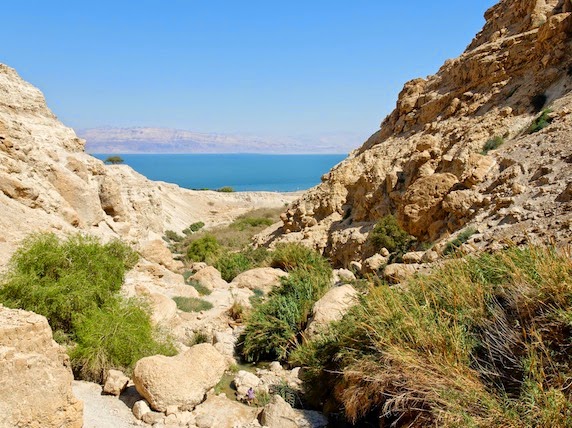(Source: shalomisraeltours.com)
Ancient travelers who made their way along the shores of the Dead Sea would no doubt shake their heads when they saw it.
How could so much water stand in such a barren place—and none of it be drinkable?
Before the obliteration of Sodom and Gomorrah, the Jordan Valley looked like the “garden of the Lord” (Genesis 13:10). But afterwards, even the many springs that bubbled beside the Dead Sea tasted too salty to swallow. The plentiful waters gave nothing in the way of sustenance.
They only offered a spiritual prompt of the need to take God seriously.
Against this depressing backdrop of death and desperation flows the Ein Gedi.
Ein Gedi—A Spring for More than Goats
If you want to find where history took place, just look for the waterholes.
Ein Gedi means, “Spring of the Wild Goat,” and suggests that animals—not just people—depended upon its fresh and plentiful streams (1 Samuel 24:1-2).
- Because Ein Gedi represented one of only two springs that offered fresh water west of the Dead Sea, every nomad, wanderer, and warrior stopped there as they passed.
- The Bible records Ammonites, Edomites, Meunites, and Moabites—Judah’s neighbors east of the Jordan—gathering there before their attack on Jehoshaphat (2 Chronicles 20:1-2).
With regional water so scant, the spring hosted numerous settlements throughout history—thousands of years of continuous habitation.
- God allotted Ein Gedi to the tribe of Judah (Joshua 15:62), from which came David.
- David’s familiarity with the oasis and its caves allowed him to select hiding places from the jealous King Saul (1 Samuel 23-24). David may have written Psalms 57 and 142 here, as the superscription for each psalm mentions David composing them in a cave.
- The Hasmoneans made Ein Gedi their royal estate and administrative center in the 2nd-century BC.
- Eusebius described Ein Gedi in his Onomasticon as being “a very large village of Jews.”
- The area has a Canaanite temple as well as Roman forts, a Byzantine fort, and an Israelite fort—all situated to protect the nearby roadway.
Next we drive to MASADA, site of the Jew’s final stand against the Romans in AD 73, ascending by cable cars to see the remains of Herod’s palatial fortress and visit the Masada Museum.
source: routestravel.com
Towering 1300 feet above the Dead Sea, Masada looks as intimidating today as it did to those who stood at its base thousands of years ago. This natural mesa looms tall across from the Lisan at the southern half of the Dead Sea.
Steep cliffs on all sides make the mountain look virtually impregnable. And it was.
Getting to the top has always come at a price. For modern visitors, that price amounts to a cable car ticket. But in antiquity, the price was a hard hike up the steep path Josephus labeled the “snake.”
In 1867, explorers rediscovered this pathway that lies along the eastern edge of Masada. For most folks, climbing the “Snake Path’’—the serpentine trail that snakes back and forth up the mountain—takes almost an hour. Going down is another story. I can testify that a person with a good set of shoes can run down the snake path in 12 minutes (especially if your group is about to leave you).
Masada Means “Stronghold”
After Rome made Herod the Great king, he came to the mesa in AD 37 to fortify it, erecting an eighteen-foot high wall around its perimeter.
- His made winter palace there, and as was true with all of Herod’s fortresses, had every comfort and convenience he could manage.
- The palace clung to the northern cliffs of Masada like a barnacle.
- Covered staircases gave access to three levels of terraces and portions of his beautiful mosaics are still visible.
After Rome destroyed Jerusalem’s temple in AD 70, a number of Jewish patriots took refuge in Masada.
- Led by Eliezar Ben Yair, they stood firm against Rome for several years.
- According to Josephus, on April 15, AD 73, the Romans crested the summit to discover that almost 1000 patriots had chosen to take their own lives rather than surrender their lives and families to the cruelty of Rome (Wars 7:394-397).
- The western side of the mesa still shows the spine of Rome’s siege ramp—an earthen incline constructed to breach the defenses of the Jewish fortress.
Masada remains a symbol of Israel’s resolve even today. Many Israeli soldiers have stood atop the mountain and uttered the oath: “Masada shall not fall again.”
We then return early afternoon to the Isrotel Hotel for leisure time to enjoy the amenities of the hotel’s spa (optional), the immense swimming pool or experience floating in the DEAD SEA at the hotel’s private beach and a delicious evening buffet.



